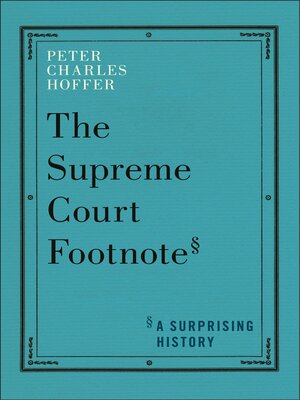
Sign up to save your library
With an OverDrive account, you can save your favorite libraries for at-a-glance information about availability. Find out more about OverDrive accounts.
Find this title in Libby, the library reading app by OverDrive.



Search for a digital library with this title
Title found at these libraries:
| Library Name | Distance |
|---|---|
| Loading... |
Finalist, 2025 PROSE Awards: Legal Studies and Criminology
A history of the humble footnote and its impact on the highest court in the land
In May 2022, a seismic legal event occurred as the draft majority opinion in Dobbs v. Jackson Women's Health was leaked. The majority aimed to eliminate constitutional protection for abortion. Amidst the fervor, an unnoticed detail emerged: over 140 footnotes accompanied the majority opinion and dissent. These unassuming annotations held immense significance, unveiling justices' beliefs about the Constitution's essence, highlighting their controversial reasoning, and laying bare the vastly different interpretations of the role of Supreme Court Justice.
The Supreme Court Footnote offers a study of the evolution of footnotes in US Supreme Court opinions and how they add to our constitutional understanding. Through a comprehensive analysis, Peter Charles Hoffer argues that as justices alter the course of history via their decisions, they import their own understandings of it through the footnotes. The book showcases how the role of the footnote within Supreme Court opinions has evolved, beginning with one of the first cases in the history of the court, Chisholm v. Georgia in 1792 (a case concerning federalism vs. states' rights) and ending with the landmark Dobbs v. Jackson case in 2022. Along the way, Hoffer demonstrates how the footnotes within these decisions reflect the changing role of the Supreme Court Justice, along with how interpretations of the constitution have transformed over time.
At once surprising and revealing, The Supreme Court Footnote proves that what appears below the line is not only a unique window into the history of constitutional law but also a source of insight as to how the court will act going forward.







